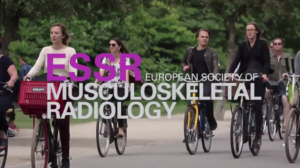MISSION AND VISION
- To enhance the standing of, and interest in, osteoporosis and the quantitative assessment of the skeleton (including bone densitometry) in the radiological community.
- To provide useful guidance and information to radiological colleagues within the ESSR and Europe generally, so they may be better informed on the current status of relevant topics, and as a consequence more uniform reports and service quality may be provided.
- To encourage radiological research in osteoporosis, bone densitometry and imaging bone structure.
CHAIRPERSON
Chairperson
Dr. Christian Krestan
Vienna, Austria
Term of office 2024-2027
CHAIRPERSON
Members
For a list of subcommittee members, please VISIT HERE
BACKGROUND
One in three women and one in twelve men will develop osteoporosis. It is a chronic, clinically relevant and important disease, in which radiologists need to have knowledge and expertise. The role of the radiologist within the diagnosis of osteoporosis is not limited to bone densitometry but also covers the detection of insufficiency fractures especially of the lumbar spine and the pelvis and the quantification of bone quality, which is currently a subject of major interest supported by the National Institute of Health in the US and the French “Institut national de la santé et de la recherche médicale”. In addition radiologists are increasingly involved in the treatment of osteoporotic fractures as they perform vertebroplasties, kyphoplasties and sacroplasties.
1. BONE DENSITOMETRY
Bone densitometry is currently the standard diagnostic technique to assess osteoporosis. According to the WHO-criteria Dual X-ray absorptiometry (DXA) of the proximal femur and the lumbar spine (as well as the distal radius) is used to diagnose osteoporosis in postmenopausal Caucasian females. In addition to correctly interpreting quantitative, areal bone densitometry measurements radiologists have to be familiar with the limitations and pitfalls of the technique. These include falsely increased BMD due to degenerative disease and aortic calcifications. It should also be considered that since BMD is an areal and not a volumetric technique, patients that are smaller in height with smaller vertebral bodies will also have lower BMD.
Quantitative CT (QCT), though currently used infrequently is a volumetric technique and BMD is determined in mg Hyroxyapatite/ ml. Thus BMD measurements are not affected by body size, overlying calcifications and also degenerative changes do not falsely increase BMD measurements as much.
2. NEW QUANTITATIVE TECHNIQUES
Quantitative Ultrasound (QUS) is mostly performed at the calcaneus and the phalanges of the hand. It has shown promising results in differentiating patients with and without osteoporotic fractures. Interest in techniques assessing trabecular and cortical architecture is substantially increasing as architecture is one component of bone quality that is not measured with bone densitometry. Magnetic resonance imaging and computed tomography based techniques such as high resolution peripheral QCT are currently used to measure bone structure.
3. DIAGNOSIS OF OSTEOPOROTIC FRACTURES
Previous studies have shown that osteoporotic compression deformities of the thoracic spine are frequently missed on lateral chest radiographs by radiologists. A considerable amount of effort has been invested by the osteoporosis group of the ESSR to teach radiologists how to diagnose and classify vertebral deformities of the spine, under the leadership of Prof. J. Adams a teaching CD rom was distributed at many conferences all over Europe. Also the International Osteoporosis Foundation (IOF) has a website specifically designed to teach radiologists how to diagnose osteoporotic fractures, which was a collaborative effort between the IOF and osteoporosis subcommittee of the ESSR (http://www.iofbonehealth.org/vfi/index-flash.html). This website was just recently updated under the leadership of Prof. Adams.
In addition to assessing vertebral fractures sacral, femoral and pelvic insufficiency fractures are a frequent complication of osteoporosis and radiologists should be aware of the fact that these are frequently missed on standard radiographs and are most sensitively visualized with MRI. However, these signal changes should not be confused with malignant disease.
4. THERAPY
In the last years vertebroplasty has been well established as a technique to treat osteoporotic fractures and related pain. This technique is predominantly performed by radiologists, either under fluoroscopy or CT guidance and has shown very good results in relieving pain. Using a transpedicular or direct approach bone cement is injected into fractured vertebral bodies. Kyphoplasty is more frequently used by orthopedic surgeons and aims at restoring height of the deformed vertebral body. Both techniques, vertebroplasty and kyphoplasty, have low complication rates, allow a significant reduction of pain, increase mobility and the quality of life of the patients. In addition sacroplasty has been introduced to treat painful fractures of the sacrum
Selected Publications from Members of the Osteoporosis Subcommittee and useful Reading on Osteoporosis
2010
Radiation exposure in X-ray-based imaging techniques used in osteoporosis.
Damilakis J, Adams JE, Guglielmi G, Link TM. Eur Radiol. 2010 Jun 18. [Epub ahead of print][Radiological diagnosis of osteoporosis] in German
Issever AS, Link TM. Radiologe. 2010 May;50(5):471-81.
Advances in Imaging of Osteoporosis and Osteoarthritis Imaging.
Link, TM. Skeletal Radiology 2010. Jun 20. [Epub ahead of print].
Ganglia of the tarsal sinus: MR imaging features and clinical findings. Bauer JS, Müller D, Sauerschnig M, Imhoff AB, Rechl H, Rummeny EJ, Woertler K.; Eur J Radiol 2010; Nov 18
BMD measurements of the spine derived from sagittal reformations of contrast-enhanced MDCT without dedicated software. Baum T, Müller D, Dobritz M, Rummeny EJ, Link TM, Bauer JS.; Eur J Radiol. 2010; Sep 17
2011
Integrated imaging approach to osteoporosis: state-of-the-art review and update.Radiographics. Guglielmi G, Muscarella S, Bazzocchi A.; 2011 Sep-Oct;31(5):1343-64. Review. PMID: 21918048
Vertebral morphometry by X-ray absorptiometry: which reference data for vertebral heights? Bone. 2011 Diacinti D, Pisani D, Del Fiacco R, Francucci CM, Fiore CE, Frediani B, Barone A, Bartalena T, Cattaruzza MS, Guglielmi G, Diacinti D, Romagnoli E, Minisola S.; Sep;49(3):526-36. Epub 2011 Jun 6. PMID: 21672644
A careful evaluation of scout CT lateral radiograph may prevent unreported vertebral fractures. Bazzocchi A, Spinnato P, Albisinni U, Battista G, Rossi C, Guglielmi G. ; Eur J Radiol. 2011 Sep 23. [Epub ahead of print] PMID: 21945354
Relationship between body composition, body mass index and bone mineral density in a large population of normal, osteopenic and osteoporotic women. Andreoli A, Bazzocchi A, Celi M, Lauro D, Sorge R, Tarantino U, Guglielmi G. ; Radiol Med. 2011 Oct;116(7):1115-23. Epub 2011 Jun 4. English, Italian. PMID: 21643640
2012
Bazzocchi A, Ciccarese F, Diano D, Spinnato P, Albisinni U, Rossi C, Guglielmi G. Dual-energy X-ray absorptiometry in the evaluation of abdominal aortic calcifications. J Clin Densitom. 2012 Apr-Jun;15(2):198-204. Epub 2012 Feb 9. PMID: 22321658
Bazzocchi A, Spinnato P, Fuzzi F, Diano D, Morselli-Labate AM, Sassi C, Salizzoni E, Battista G, Guglielmi G. Vertebral fracture assessment by new dual-energy X-ray absorptiometry. Bone. 2012 Apr;50(4):836-41. Epub 2012 Jan 31. PMID: 22316655
Salcuni AS, Palmieri S, Carnevale V, Morelli V, Battista C, Guarnieri V, Guglielmi G, Desina G, Eller-Vainicher C, Beck-Peccoz P, Scillitani A, Chiodini I. Bone involvement in aldosteronism. J Bone Miner Res. 2012 May 15. PMID: 22589146
Fusaro M, Noale M, Viola V, Galli F, Tripepi G, Vajente N, Plebani M, Zaninotto M, Guglielmi G, Miotto D, Dalle Carbonare L, D’Angelo A, Naso A, Grimaldi C, Miozzo D, Giannini S, Gallieni M; for the VItamin K Italian (VIKI) Dialysis Study Investigators. Vitamin K, vertebral fractures, vascular calcifications and mortality: Vitamin K Italian (VIKI) dialysis study. J Bone Miner Res. 2012 Jun 12. PMID: 22692665
Diacinti D, Guglielmi G, Pisani D, Diacinti D, Argirò R, Serafini C, Romagnoli E, Minisola S, Catalano C, David V. Vertebral morphometry by dual-energy X-ray absorptiometry (DXA) for osteoporotic vertebral fractures assessment (VFA). Radiol Med. 2012 Jun 28. PMID: 22744340
Bazzocchi A, Diano D, Battista G, Albisinni U, Rossi C, Guglielmi G. New dual-energy X-ray absorptiometry equipment in the assessment of vertebral fractures: technical limits and software accuracy. Skeletal Radiol. 2012 Jul;41(7):823-9. Epub 2011 Oct 19. PMID: 22005799
Bazzocchi A, Ferrari F, Diano D, Albisinni U, Battista G, Rossi C, Guglielmi G. Incidental findings with dual-energy x-ray absorptiometry: spectrum of possible diagnoses. Calcif Tissue Int. 2012 Aug;91(2):149-56. Epub 2012 May 24. PMID: 22623178
BMD measurements of the proximal femur from routine contrast-enhanced MDCT datasets correlate with DXA, ; Gruber M, Bauer JS, Dobritz M, et al.;European Radiology, 2012.
Baum, T., Y. Dütsch, …, Bauer J.S.;Reproducibility of trabecular bone structure measurements of the distal radius at 1.5T and 3.0T MRI. Journal of Computer Assisted Tomography, 2012.
Baum T, Müller D, Dobritz M, Wolf P, Rummeny EJ, Link TM, Bauer JS.;Converted Lumbar BMD Values Derived from Sagittal Reformations of Contrast-Enhanced MDCT Predict Incidental Osteoporotic Vertebral Fractures. Calcif Tissue Int. 2012 Jun;90(6):481-7. Epub 2012 Apr 7.
PROCEDURE TO JOIN THE SUBCOMMITTEE
If you are interested in osteoporosis and would like to participate in our meetings, please send your name, address, telephone and fax numbers and email address to the ESSR Office. If you know of other radiologists involved in this field, please encourage them to send the relevant information to us (and apply to join the ESSR, if they are not already members).




